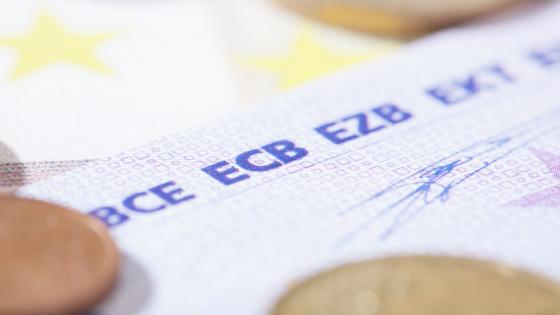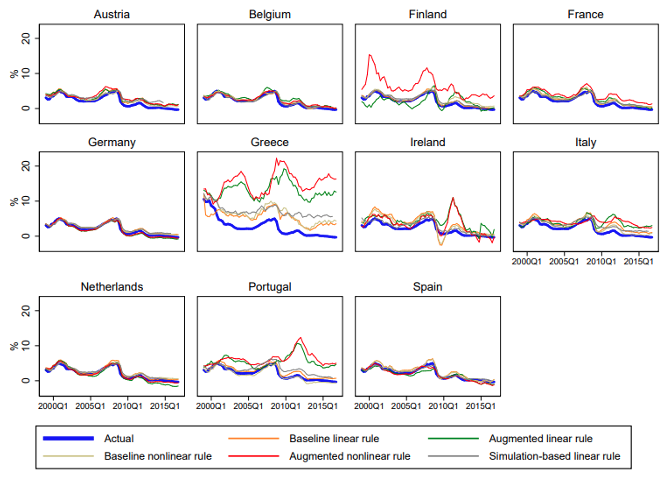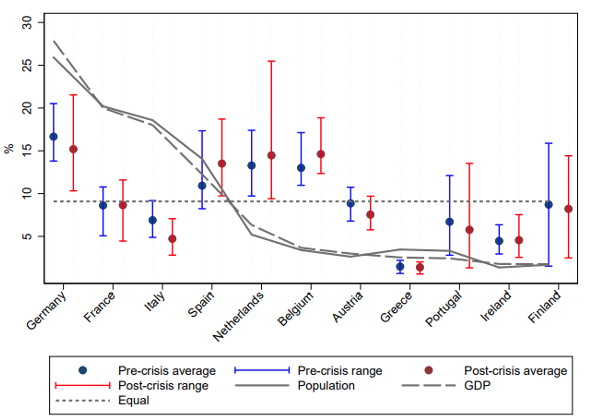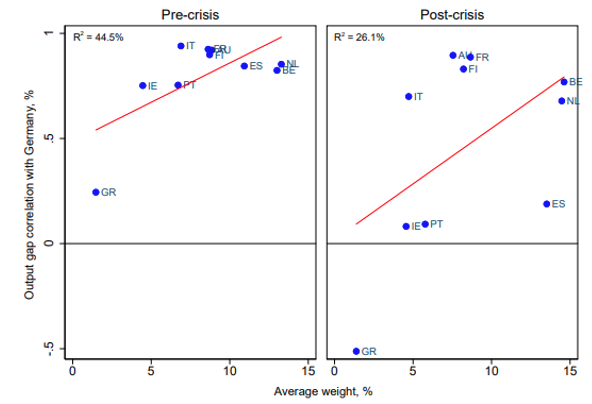Prior to European monetary unification, several authors pointed out that a unique monetary policy would be unable to address asymmetric shocks (e.g. Bayoumi and Eichengreen 1992), while others questioned just how independent the ECB would be from political institutions (Alesina and Grilli 1991). As the sovereign debt crisis unfolded, impacting member states differently, the possible benefit of country-specific monetary policy responses gained momentum, and a discussion concerning the transparency of decision making within the euro area came to the fore (Caporale and Cipollini, 2002). Some policymakers openly advocated for specific countries to exit the euro area, while rising Euroscepticism and a decline in trust in the ECB added pressure (Bergbauer et al. 2019, Roth and Jonung 2019). The call for greater transparency in decision making also gains prominence in light of discussions concerning increasing the shared fiscal capacity of euro area countries.
In a recent paper (Pereira and Tavares 2019), we provide quantitative evidence that informs this debate by extracting implicit country-specific weights from the reference rate in the ECB’s conventional monetary policy, exploring quarterly data from 1999 to 2016. Country-specific weights are computed from the difference between the ECB’s reference interest rate and an estimated counterfactual interest rate for each of the EMU11 countries. To obtain these counterfactual interest rates, we model each national central banks’ reaction function in the period before introduction of the euro, and then estimate what the likely response would be to the country’s post-euro macroeconomic fundamentals. Anchored in the seminal contribution of Clarida et al. (1998) on monetary policy rules, we explore the robustness of our results using five different Taylor rule specifications.
Counterfactual interest rates
Our first result is illustrated in Figure 1, where we plot both the actual rate, delivered by the ECB, and the five distinct counterfactual interest rate paths, estimated as counterfactuals on the basis of national central banks’ behaviour prior to the introduction of the euro in 1999. The sample of countries can be divided into two groups: countries where counterfactual estimates track actual interest rates closely (Germany, the Netherlands, Austria, Belgium, France, and Spain) and countries where the opposite holds (Finland, Ireland, Italy, Portugal, and, most noticeably, Greece). The exercise for Greece shows a marked decoupling between estimated counterfactual interest rates and the actual rate. The magnitude and frequency of deviations between actual and counterfactual rates are reflected in the country-specific weights, so that the bigger the former, the smaller the latter.
Figure 1 Actual and counterfactual interest rate paths (%)
Source: Pereira and Tavares (2019).
Notes: The counterfactual interest rate paths correspond to the estimated series using each of the five different reaction functions based on different types of Taylor rules.
Implicit country weights
Using the counterfactual interest rate paths, we compute country-specific weights for the pre-crisis (1999-2009) and the post-crisis period (2010-2016). Figure 2 shows the average weight pre- and post-crisis for each country, the maximum-minimum range of weight estimates, as well as lines representing population and GDP weights, and a horizontal line for identical weights. The results across different estimation procedures show Germany, being attributed the largest weights in the conduct of ECB’s interest rate policy, closely followed by the Netherlands, Belgium, and Spain. Ireland, Portugal, Italy, and especially Greece are attributed systematically smaller weights. After the financial crisis, most countries lose weight to the benefit of Spain, Belgium, and the Netherlands, while Germany’s centrality to policymaking seems to wane somewhat. In general, our weight estimates for the crisis years are estimated with lower precision, which may reflect the higher uncertainty surrounding these estimates.
Figure 2 Average weight and maximum-minimum range of weight estimates (%)
Source: Pereira and Tavares (2019).
Notes: The average weight estimate consists of the average of the five different implicit weight estimates, whereas the maximum-minimum range corresponds to the maximum and minimum weights of those estimated. The population and GDP series presented consist of the country-specific averages from 2010 to 2016.
Weights and economic integration
A much-debated feature of monetary unification is the potential feedback loop between sharing of a common currency and the synchronisation of underlying economic shocks. We thus examine the extent to which country-specific weights may reflect the degree of real integration with Germany, the euro area’s largest economy and the perceived anchor for the ECB’s decision making (Beyer et al. 2008). Figure 3 compares average country weights with two measures of economic integration: the correlation between member states’ and Germany’s output gaps, and the same correlation for supply shocks.
For the entire period, we observe that estimated implicit weights are positively associated with a higher correlation of the country output gap and supply shock with Germany. In the period of 1999-2009, output gaps across the euro area display a high correlation with Germany’s, the exception being Greece. This pattern was partially reverted in the period of 2010-2016, i.e. after the crisis, more noticeably so in the case of Greece, Ireland and Portugal, and Spain, precisely the countries with smaller weights, with the exception of the latter. Regarding supply shocks, the crisis also made them more asymmetric for Greece and Ireland.
Figure 3 Average country weights and synchronisation of output gaps (top) and supply shocks (bottom) between each member state and Germany (%)
Notes: Output gaps were obtained using a Hodrick-Prescott filter (λ = 1600) on quarterly GDP and supply shocks using a Blanchard and Quah (1989) decomposition, as adapted by Bayoumi and Eichengreen (1992).
Source: Pereira and Tavares (2019).
Towards risk-sharing and further integration
In sum, the novelty of our approach is a method to infer, from the ECB’s observed interest rate policy, the likely relative weights given to the economic context of distinct member countries. Our results show that the countries’ implicit weights are more equally distributed than population and output, so that the largest economies, such as Germany and France, receive weights that are considerably below their shares of output and population. Across different specifications, we find that greater weights are awarded to Germany, Belgium, and the Netherlands, with Portugal and Italy, and especially Greece and Ireland, securing the smallest weights. These results do not change significantly when we analyse the period during and after the sovereign debt crisis. Finally, smaller weights tend to be associated with countries whose output gap and supply shocks are less correlated with Germany’s.
The euro area is, arguably, the most important monetary policy experience ever. However, the ECB’s policymaking suffers frequent criticism regarding perceived imbalances insofar as how different, country specific economic fundamentals are taken into consideration. Our results suggest that the different implicit country weights inferred from ECB’s interest rate policy do not differ to a degree that suggests a serious political liability. However, further consideration of an economy’s specific circumstances may be warranted, especially in times of severe downturns such as the sovereign debt crisis and the current health crisis, as is currently illustrated in the flexibility underlying the ECB’s pandemic emergency purchase programme (PEPP). In parallel, more measures can be taken to further real integration and increase the symmetry of shocks across economies. Structural reforms can increase both countries’ resilience to shocks (Draghi 2017) and real integration. Finally, further risk-sharing and fiscal insurance mechanisms at the euro area level should be considered as, naturally, monetary policy itself cannot ever fully achieve income stabilisation in light of asymmetric disturbances.
References
Alesina, A and V Grilli (1991), “The European Central Bank: Reshaping Monetary Politics in Europe”, Technical report, National Bureau of Economic Research.
Bayoumi, T and B Eichengreen (1992), “Shocking Aspects of European Monetary Unification”, Technical report, National Bureau of Economic Research.
Bergbauer, S, J-F Jamet, E Persson and N Hernborg (2019), “The Reputation of the Euro and the ECB: Interlinked or Disconnected?“, Paper presented at the EUSA conference.
Blanchard, O J and D Quah (1989), “The Dynamic Effects of Aggregate Demand and Supply Disturbances”, American Economic Review 79(4): 655–673.
Beyer, A, V Gaspar, C Gerberding and O Issing (2008), “Opting out of the Great Inflation: German monetary policy after the break down of Bretton Woods”, Technical report, National Bureau of Economic Research.
Caporale, G M and A Cipollini (2002), “The euro and monetary policy transparency”, Eastern Economic Journal 28(1): 59–70.
Clarida, R, J Galí and M Gertler (1998), “Monetary Policy Rules in Practice: Some International Evidence”, European Economic Review 42: 1033–1067.
Draghi, M (2017), “Structural reforms in the euro area”, ECB Conference, Frankfurt am Main.
Pereira, M and J Tavares (2019), “Extracting Implicit Country Weights from ECB’s Monetary Policy”, CEPR Discussion Paper No. DP14090.
Roth, F and L Jonung (2019), “Public support for the euro and trust in the ECB: The first two decades”, VoxEU.org, 13 December.








